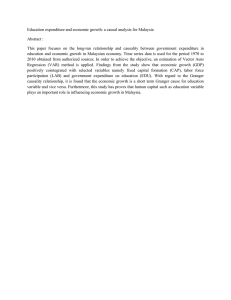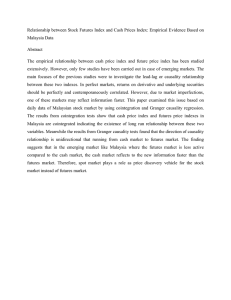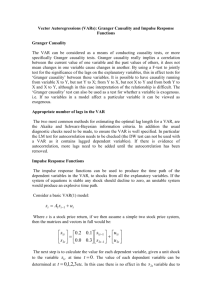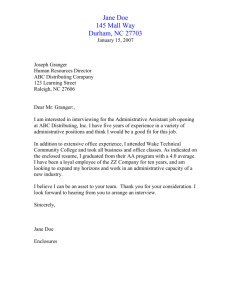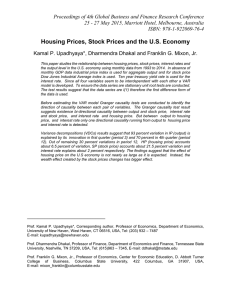Vectorautoregressive- VAR Models and Cointegration Analysis
advertisement
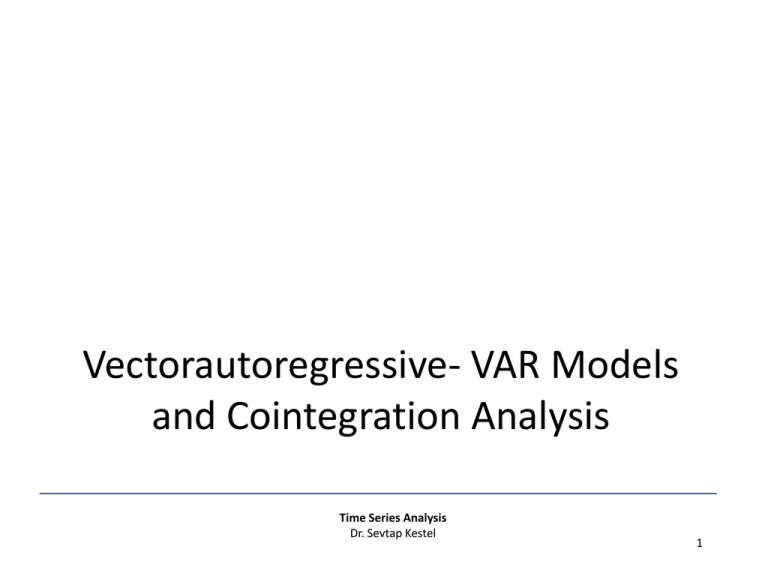
Vectorautoregressive- VAR Models
and Cointegration Analysis
Time Series Analysis
Dr. Sevtap Kestel
1
VECTOR TIME SERIES
2
VECTOR TIME SERIES
3
Vectorautoregression
Vector autoregression (VAR) is an econometric model used to capture the evolution
and the interdependencies between multiple time series, generalizing the univariate
AR Models. All the variables in a VAR are treated symmetrically by including for each
variable an equation explaining its evolution based on its own lags and the lags of all
the other variables in the model.
A VAR model describes the evolution of a set of k variables measured over the same
sampleperiod (t єT) as a linear function of only their past evolution.
The variables are collected in a k x 1 vector yt, which has as the ith element yi,t , the
time t observation of variable yi.
For example, if the ith variable is GDP, then yi,t is the value of GDP at t.
A (reduced) p-th order VAR, VAR(p), is
yt c A1 yt 1 A2 yt 2 ... Ap yt p t
where c is a k x 1 vector of constants (intercept)
Ai is a k x k matrix (for every i = 1, ..., p) and
εt is a k x 1 vector of error terms satisfying the conditions.
Properties:
E[ t ] 0 every error term has mean zero
E[ t t ] the contemporaneous covariance matrix of errors
E[ t tk ] 0
Order of integration of the variables
Note that all the variables used have to be of the same order of integration.
We have the following cases:
All the variables are I(0) (stationary):
one is in the standard case, ie. a VAR in level
All the variables are I(d) (non-stationary) with d>1:
The variables are conintegrated: the error correction term has to be included in the
VAR.
The model becomes a Vector error correction model (VECM) which can be seen as a
restricted VAR.
The variables are not cointegrated:
the variables have first to be differenced d times and one has a VAR in difference
Example: VAR(1)
Suppose {y1t}tєT denote real GDP growth, {y2t} tєT denote inflation
y1t c1 A11
y c A
2t 2 21
A12 y1,t 1 1t
A22 y2,t 1 2t
y1t c1 A11 y1,t 1 A12 y2,t 1 1t
y2t c2 A21 y1,t 1 A22 y2,t 1 2 t
One equation for each variable in the model.
The current (time t) observation of each variable depends on its own lags
as well as on the lags of each other variable in the VAR.
VAR(1) PROCESS
• Example:
1.1 0.3
Yt
Yt 1 Z t
0.6 0.2
1.1 0.3
I
0
.
6
0
.
2
det I 1.1 0.2 0.60.3
2 1.3 0.4 0
1 0.8, 2 0.5
The process is stationary.
8
Structural VAR (SVAR) with p lags
B0 yt c0 B1 yt 1 B2 yt 2 ... B p yt p et
where c0 is a k x 1 vector of constants, Bi is a k x k matrix, i = 0, ..., p, and
et is a k x 1 vector of error terms.
The main diagonal terms of the B0 matrix (the coefficients on the ith
variable in the ith equation) are scaled to 1.
The error terms et (structural shocks) satisfy the conditions and
particularity that all the elements off the main diagonal of the covariance
matrix E(etet') = Σ are zero. That is, the structural shocks are
uncorrelated.
IMPULSE RESPONSE FUNCTION
The key tool to trace short run effects with an SVAR is
the impulse response function.
yt c A1 yt 1 A2 yt 2 ... Ap yt p t
can be expressed as MA(‡)
yt c t 1 t 1 2 t 2 ... ( B) t
yt l
l
'
t
the row i , column j element of
l
identifies the consequences of a one-unit increase in the jth variable’s innovation at
date t (εtj) for the value of the ith variable at time t+l, holding all other innovations
at all dates constant. A plot of the row i, column j element of as a function of lag l is
called the non-orthogonalized impulse response function.
l
GRANGER CAUSALITY
• In time series analysis, sometimes, we would
like to know whether changes in a variable will
have an impact on changes other variables.
• To find out this phenomena more accurately,
we need to learn more about Granger
Causality Test.
12
GRANGER CAUSALITY
• In principle, the concept is as follows:
• If X causes Y, then, changes of X happened
first then followed by changes of Y.
13
GRANGER CAUSALITY
• If X causes Y, there are two conditions to be
satisfied:
1. X can help in predicting Y. Regression of X on Y
has a big R2
2. Y can not help in predicting X.
14
COINTEGRATION
Cointegration
• In many time series, integrated processes are
considered together and they form equilibrium
relationships.
– Short-term and long-term interest rates
– Income and consumption
• These leads to the concept of cointegration.
• The idea behind the cointegration is that
although multivariate time series is integrated,
certain linear transformations of the time
series may be stationary.
16
SPURIOUS REGRESSION
• If we regress a y series with unit root on
regressors who also have unit roots the usual t
tests on regression coefficients show statistically
significant regressions, even if in reality it is not
so.
• The Spurious Regression Problem can appear
with I(0) series
• In a Spurious Regression the errors would be
correlated and the standard t-statistic will be
wrongly calculated because the variance of the
errors is not consistently estimated. In the I(0)
case the solution is:
ˆ ˆ
t t - distributi on , where ˆ (long - run varian ce of ˆ )1/2
ˆ
17
SPURIOUS REGRESSION
Typical symptom: “High R2, t-values, F-value, but low DW”
1. Egyptian infant mortality rate (Y), 1971-1990, annual data,
on Gross aggregate income of American farmers (I) and
Total Honduran money supply (M)
Y ^ = 179.9 - .2952 I - .0439 M, R2 = .918, DW = .4752, F = 95.17
(16.63) (-2.32) (-4.26) Corr = .8858, -.9113, -.9445
2. US Export Index (Y), 1960-1990, annual data, on Australian
males’ life expectancy (X)
Y ^ = -2943. + 45.7974 X, R2 = .916, DW = .3599, F = 315.2
(-16.70) (17.76)
Corr = .9570
18
Cointegration
If two or more series are themselves non-stationary, but a linear combination
of them is stationary, then the series are said to be cointegrated.
Example:
A stock market index and the price of its associated follow a random walk by time. Testing
the hypothesis that there is a statistically significant connection between the futures price
and the spot price could now be done by testing for a cointegrating vector.
The usual procedure for testing hypotheses concerning the relationship between nonstationary variables was to run Ordinary Least Squares (OLS) regressions on data
which had initially been differenced.
Although this method is correct in large samples, cointegration provides more
powerful tools when the data sets are of limited length, as most economic time-series
are.
The two main methods for testing for cointegration are:
The Engle-Granger three-step method.
The Johansen procedure.
Granger Causality
• According to Granger, causality can be further subdivided into long-run and short-run causality.
• This requires the use of error correction models or
VECMs, depending on the approach for determining
causality.
• Long-run causality is determined by the error
correction term, whereby if it is significant, then it
indicates evidence of long run causality from the
explanatory variable to the dependent variable.
• Short-run causality is determined as before, with a test
on the joint significance of the lagged explanatory
variables, using an F-test or Wald test.
20
Granger Causality
• Before the ECM can be formed, there first has to
be evidence of cointegration, given that
cointegration implies a significant error
correction term, cointegration can be viewed as
an indirect test of long-run causality.
• It is possible to have evidence of long-run
causality, but not short-run causality and vice
versa.
• In multivariate causality tests, the testing of longrun causality between two variables is more
problematic, as it is impossible to tell which
explanatory variable is causing the causality
through the error correction term.
21
Engle-Granger Approach
Estimation of parameters can be done by OLS estimation of
linear regression equation:
Yt 0 1Y2t .. MYMt t
Dickey-Fuller t test is applied to the OLS residuals
ˆt
Rejecting the null hypothesis of non-stationarity concludes “cointegration
relationship” does exist.
Three-step approach
•Determine the I(d) for every variable
Dickey Fuller, Perron tests H0: series is non-stationary
•Estimate the cointegration relation by OLS regression
•Test the residuals for stationarity
y1t 0 1 y2 t t t y1t 0 1 y2 t
ˆ y ˆ ˆ y
t
1t
0
1
2t
H0: series are not cointegrated
ADF Test does not give correct critical values because of the OLS
residuals
we use MacKinnon Table to determine the critical values
Multicointegration extends the cointegration technique beyond
two variables, and occasionally to variables integrated at
different orders.
Error Correction Model
Granger Representation Theorem
Determination of the dynamic relationship between
cointegrated variables in terms of their stationary error
terms.For bivariate case: Two integrated I(1) variables
y1t
and
y 2t
yielding one cointegrated combination
p 1
y1t 1 t 1 (a11 i y1t i a12 i y2 t i ) 1t
i 1
t
I (0)
p 1
y2 t 2 t 1 ( a21i y1t i a22 i y2 t i ) 1t
i 1
Estimate parameters by OLS.
Regression with only stationary variables on both sides.
Multivariate Cointegration Analysis - Johansen Test
VAR(1) having M I(1) variables can be expressed as:
Yt Yt 1 t
where: Y, ì and å are (Mx1) vectors and à is a (MxM) matrix
Johannsen Test
The approach of Johansen is based on the maximum likelihood
estimation of the matrix (Γ - I) under the assumption of normal
distributed error variables. Following the estimation the
hypotheses
H0: r = 0, H0: r = 1, …, H0:r = M-1
are tested using likelihood ratio (LR) tests.
The Johansen Trace and Maximal
Eigenvalue Tests
• To test whether the variables are cointegrated
or not, one of the well-known tests is the
Johansen trace test. The Johansen test is used
to test for the existence of cointegration and is
based on the estimation of the ECM by the
maximum likelihood, under various
assumptions about the trend or intercepting
parameters, and the number k of
cointegrating vectors, and then conducting
likelihood ratio tests.
26
Example: Exchange rate, interest rates, S&P 500(GLOBAL) index, ISE index
Series: GLOBAL EXCHANGE_RATE INTEREST_RATE ISE
Trace Test
Lags interval (in first differences): 1 to 4
Hypothesized
Trace
0.05
No. of CE(s)
Eigenvalue
Statistic
Critical Value
Prob.**
None *
0.065285
156.7717
47.85613
0.0000
At most 1 *
0.017048
38.96042
29.79707
0.0034
At most 2
0.005118
8.955273
15.49471
0.3695
At most 3
1.20E-06
0.002096
3.841466
0.9599
Trace test indicates 2 cointegrating eqn(s) at the 0.05 level
* denotes rejection of the hypothesis at the 0.05 level
Unrestricted Cointegration Rank Test (Maximum Eigenvalue)
Hypothesized
Max-Eigen
0.05
No. of CE(s)
Eigenvalue
Statistic
Critical Value
Prob.**
None *
0.065285
117.8113
27.58434
0.0000
At most 1 *
0.017048
30.00514
21.13162
0.0022
At most 2
0.005118
8.953177
14.26460
0.2901
At most 3
1.20E-06
0.002096
3.841466
0.9599
Max-eigenvalue test indicates 2 cointegrating eqn(s) at the 0.05 level
* denotes rejection of the hypothesis at the 0.05 level **MacKinnon-Haug-Michelis (1999) p-values
1 Cointegrating Equation(s):
Log likelihood
-46009.85
Normalized cointegrating coefficients (standard error in parentheses)
GLOBAL
EXCHANGE_R
ATE
INTEREST_RAT
E
ISE
1.000000
-0.000120
-16.55210
-0.026394
(0.00014)
(1.44457)
(0.00218)
Log likelihood
-45994.85
2 Cointegrating Equation(s):
Normalized cointegrating coefficients (standard error in parentheses)
GLOBAL
EXCHANGE_R
ATE
INTEREST_RAT
E
ISE
1.000000
0.000000
-15.66567
-0.024910
(1.30729)
(0.00194)
7382.376
12.36210
(1649.84)
(2.44689)
0.000000
1.000000
Therefore, we can conclude that in
the long term these three variables
are cointegrated and there are 2
cointegration equations
Pairwise Granger Causality Tests
Date: 07/20/08 Time: 10:40
Granger Causality Test:
In order to compare
pairwise variables
Granger Causality Tests is
used
Sample: 1/02/2001 12/31/2007
Lags: 5
Null Hypothesis:
INTEREST_RATE does not Granger
Cause EXCHANGE_RATE
Obs
F-Statistic
Probability
174
5
28.3482
1.1E-27
32.1459
2.0E-31
58.2545
3.6E-56
2.31559
0.04151
21.4690
6.7E-21
1.16105
0.32611
12.2991
9.7E-12
0.10286
0.99158
2.98831
0.01084
1.48645
0.19105
20.7727
3.3E-20
1.91422
0.08894
EXCHANGE_RATE does not Granger Cause
INTEREST_RATE
ISE does not Granger Cause EXCHANGE_RATE
174
5
EXCHANGE_RATE does not Granger Cause ISE
GLOBAL does not Granger Cause
EXCHANGE_RATE
174
5
EXCHANGE_RATE does not Granger Cause GLOBAL
ISE does not Granger Cause INTEREST_RATE
174
5
INTEREST_RATE does not Granger Cause ISE
GLOBAL does not Granger Cause INTEREST_RATE
174
5
INTEREST_RATE does not Granger Cause GLOBAL
GLOBAL does not Granger Cause ISE
ISE does not Granger Cause GLOBAL
174
5
ARDL APPROACH TO
COINTEGRATION
AUTOREGRESSIVE DISTRIBUTED LAGS (ARDL)
APPROACH
• In regression analysis if model includes both
current and lagged values for independent
variables it is called distributed lags model and
if model also includes lagged values of
dependent variable it is called as
autoregressive model (Gujarati, 2004).
AUTOREGRESSIVE DISTRIBUTED LAGS (ARDL)
APPROACH
• Autoregressive distributed lags method allows us
to express cointegrated behavior of variables
which have different order of integration.
• ARDL procedure is irrespective whether variables
used in model are I(0), I(1) or mutually
cointegrated (Peseran et al., 2001).
ARDL MODEL REPRESENTATION
BOUNDS TESTING PROCEDURE
• Cointegration test for ARDL method is applied
through bound testing procedure
• In this test there are two set of asymptotic values
which assume that all variables are I(1) in one set
and I(0) in another. These two sets provide critical
value bounds for cointegration for both I(1) and
I(0) data sets.
BOUNDS TESTING PROCEDURE
• For applying ARDL procedure 3 steps are required as:
– Applying bounds testing procedure for detecting
cointegration ranks between variables
– Estimating long run relationship coefficients with respect
to cointegration relations estimated in first step and
– Estimating short run dynamic coefficients through vector
error correction modeling.
BOUNDS TESTING PROCEDURE
DECISION RULE FOR THE TEST
• Test on the null hypothesis through an F-statistics and the critical
values calculated by Peseran et al. (2001)
• It is assumed that lower bound critical values could be used for I(0)
variables and upper bound critical values are used for I(1) variables.
– if computed F-statistics is less than lower bound critical values the null
hypothesis is rejected that there is no long run relationship between
variables
– if computed F-statistics is greater than the upper bound value, it could be
claimed that variables used in the model are cointegrated.
– if computed F-statistic falls between the lower and upper bound values,
then the test results are inconclusive
EXAMPLE OF BOUNDS TESTING PROCEDURE
Cointegration hypothesis
F-statistics
F(CON|GDP,IND,LOS,PRICE,URB)
3.1012**
F(GDP|CON,IND,LOS,PRICE,URB)
6.3478*
F(IND|CON,GDP,LOS,PRC,URB)
7.2093*
F(LOS|CON,GDP,IND,PRICE,URB)
1.8595
F(PRC|CON,GDP,IND,LOS,URB)
5.5008*
F(URB|CON,GDP,IND,LOS,PRC)
0.88845
significance at 1%, ** at 2.5% levels with respect to Pesaran and Pesaran (1997)
critical values.
*
Bounds Test results indicates that there are four cointegated relations when
dependent variables are selected as annual electricity consumption, GDP,
industry value added and mean adjusted annual average electricity prices
EXAMPLE OF BOUNDS TESTING PROCEDURE
VECTOR ERROR CORRECTION MODELS
• After implementing Bounds-Testing procedure to determine cointegrating
relationships, short and long run coefficients and related Error Correction
Models (ECM) have been estimated within ARDL method whose orders
are selected with respect to Schwarz Information Criterion (SIC).
• In other words, vector error correction could be described as a restricted
vector autoregression, used for cointegrated nonstationary variables.
• VECM is useful for determining short term dynamics between variables by
restricting long run behavior of variables. It restricts long run relationships
through their cointegrating relations and error correction term represents
the deviation from long run equilibrium.
VECTOR ERROR CORRECTION MODELS
EXAMPLE FOR ESTIMATING COEFFICIENTS
The long run coefficient estimates and ECM. Dependent variable CONS, ARDL(3,2,2,3,3,3)
(a) Estimated Long Run Coefficients
Regressor
Coefficients
Standard Error
T-Ratio (Prob*1%,**5%)
GDP
0.0020823
0.1058E-3
19.6864*
IND
-0.50248
0.052200
-9.6260*
LOS
1.9291
0.059938
32.1848*
PRC
-0.17769
3.6958
-0.048078*
URB
1977.1
104.0641
18.9993*
Constant
-627.1865
37.8846
-16.5551
(a) Error Correction Representation for the ARDL Model
ΔCON(-1)
1.1063
0.23387
4.7303*
ΔCON(-2)
0.63176
0.18166
3.4777*
ΔGDP
0.0027787
0.4203E-3
6.6117*
ΔGDP(-1)
-0.0017604
0.4911E-3
-3.5848*
ΔIND
-0.74040
0.14494
-5.1084*
ΔIND(-1)
0.42188
0.13797
3.0579*
ΔLOS
2.7343
0.44020
6.2116*
ΔLOS(-1)
-0.035601
0.46645
-0.076323(.940)
ΔLOS(-2)
-2.0454
0.49798
-4.1074*
ΔPRC
-21.6140
6.7027
-3.2247*
ΔPRC(-1)
-14.7163
6.7179
-2.1906**
ΔPRC(-2)
-19.7450
8.4128
-2.3470**
ΔURB
2992.8
1910.6
1.5664(.132)
ΔURB(-1)
141.2130
2060.3
0.068541(.946)
ΔURB(-2)
-5826.9
1823.4
-3.1957*
INTERCEPT
-1286.2
192.2404
-6.6905*
ECM(-1)
-2.0507
0.30552
-6.7122*
EXAMPLE FOR ESTIMATING COEFFICIENTS
REFERENCES
•
•
•
•
•
•
Pesaran, M.H., Shin, Y., Smith, R.J.,2001. Bounds testing approaches to the analysis of
level relationships. Journal of Applied Econometrics. 16, 289-326.
Pesaran M.H., and Pesaran B.,1997. Working with Microfit 4.0: interactive econometric
analysis. Oxford University Press.
Hamilton J.D.A., 1994. The time series analysis. New Jersey, Princeton University Press.
Engle, R.F., Granger, C.W.J, 1987. Co-integration and error correction: Representation,
estimation and testing. Econometrica. 55, 251-276.
World Bank Statistics Service (data resource). Available at: http://data.worldbank.org/
(Accessed: 4.29.2013).
TEIAS Electricity Statistics (data resource). Available at:
http://www.teias.gov.tr/istatistikler.aspx (Accessed: 4.29.2013).
